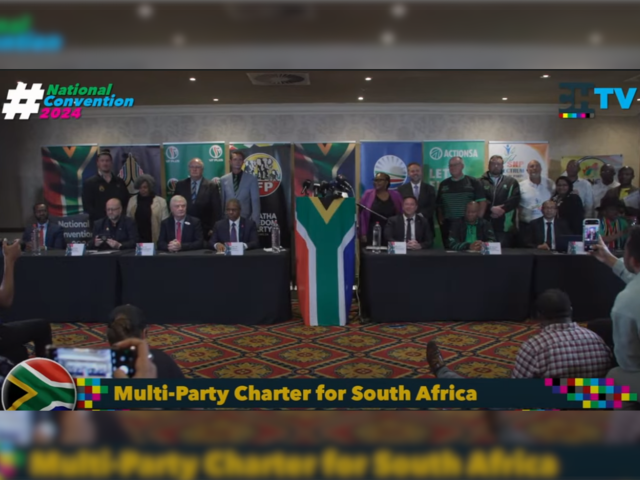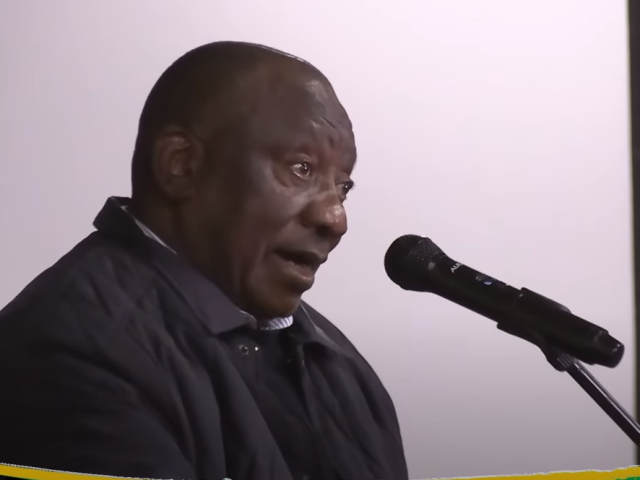-
Ramaphosa over-inflated the number of South Africans who receive social grants today and understated the number who did in 1994, giving the impression that the increase has been more marked than it really is.
-
Similarly, there’s no evidence only 36% of South Africans had access to electricity in 1994 – the numbers point to it being closer to 53% – which makes today’s 92% connected less of an achievement.
-
The president was right about the pledges raised by an investment programme launched in 2018 and how many South Africans are currently employed, but he understated unemployment numbers and overstated the number of job opportunities created by his employment stimulus programme.
The African National Congress (ANC) has launched what it calls a “historic” review of the promises made in its 2019 election manifesto, as South Africa’s ruling party prepares to face voters in 2024.
Through the review, the ANC said it would subject itself to “robust and critical public scrutiny” of its record. The process would look at progress made over the last 30 years, and not just the last five years, Cyril Ramaphosa, president of both the party and the country, said.
Kicking off what is to be a country-wide tour, Ramaphosa took to the stage at Soweto’s Dobsonville Stadium in Gauteng province on 4 September and admitted there were goals the party had failed to meet.
“The South Africa we live in today is very different from the South Africa we all lived in 1994. Everybody agrees,” he said, before going on to give examples.
We checked how the president’s claims at the launch stacked up against the data.
The government had expanded its social grant system, Ramaphosa said, and as a result, 18 million people were receiving social grants.
This claim also appears in the published transcript of Ramaphosa’s speech, but here the figure is given as 18.6 million.
The South African Social Services Agency, or Sassa, administers and delivers social relief, such as pensions and child support grants, to citizens.
Sassa’s July 2023 Social Assistance Report, the latest available, notes that 19,008,314 social grants were given to 11,856,505 recipients in South Africa at the end of that month.
Ramaphosa may have confused the number of grants with the number of recipients. Some people receive more than one grant, including parents who may receive multiple child support grants for multiple children.
But even if Ramaphosa was referring to the number of grants, his figures are out of date.
As far back as April 2022, there were 18,677,339 grants being issued.
This figure was also included in the published, but not the live, version of the speech.
Again, Ramaphosa’s speech doesn’t match data published by Sassa. In its 2021/22 annual report, Sassa chief executive Busisiwe Memela-Khambula said: “Over the years, Sassa has improved the social assistance coverage from about 2.5 million social grants in 1999 to more than 18.6 million grants in payment at the end of March 2022.”
The appendix to a 2002 Sassa report included historical data that showed there were 2,949,392 social grant recipients in April 1999. This report had been preserved by the Parliamentary Monitoring Group, an information service that provides records and documents of all parliamentary committee proceedings.
The figure is in line with a 2009 working paper by researchers at Stellenbosch University in the Western Cape province, which noted that there were around 2.4 million social grant recipients in the country in 1998.
Reports published in 1998/99 and 1999/2000 by the South African Human Rights Commission showed there were roughly 2.8 million people receiving social grants in 1998, and up to 3 million in 2000.
All data sources indicate that the figure of 2 million in Ramaphosa’s speech was understated, making for a more impressive record.
The “R350 grant” that Ramaphosa referred to is the special Covid-19 social relief of distress (or SRD) grant. It was introduced in May 2020 to offset the economic impact of the Covid-19 pandemic.
Since then, the grant has been extended several times, most recently until 2024. It provides a monthly sum of R350.
To qualify for the grant, a person must not be receiving any other grants or state support. And SRD grant recipients are not counted in Sassa’s regular reports. So anyone who does receive the grant would be an additional person receiving support from the government.
During his February 2023 state of the nation address, Ramaphosa claimed that 10 million people were receiving the R350 grant. At the time, this figure was correct. Sassa said in its 2021/22 annual report that the grant “brought in new beneficiaries amounting to more than 10.2 million at the end of March 2022”.
By October 2022, however, minister of social development Lindiwe Zulu said that the number had dropped to 7.5 million people, after eligibility requirements for the grant were tightened.
Unfortunately, Sassa has not published more recent figures in any of its reports. Africa Check has contacted the department to ask how many people currently receive the SRD grant, and will update this report with their response.
Until then, we rate this claim unproven.
At the end of July 2023, there were 11,856,505 social grant recipients. If Ramaphosa is correct that around 10 million people receive the SRD grant, the total number of grant recipients would be just under 22 million.
But since only 7.5 million people were receiving the SRD grant in October 2022, the total figure is likely less than that.
Touching on trade and investment, Ramaphosa claimed R1.5 trillion had been raised through an investment programme.
The South African Investment Conference (SAIC) was launched in 2018, in order to promote the country locally and globally as an investment destination and trade partner.
Announcing the initiative during his 2018 state of the nation address, Ramaphosa said: “We are aiming through the investment conference to generate at least US$100 billion in new investments over the next five years.”
The exchange rate at the time meant the target in rands, the local currency, translated to R1.2 trillion.
Five investment conferences have been held to date, with investment pledges totalling R1.47 trillion.
|
South African Investment Conference |
Date held |
Amount committed (in billions) |
|
1st investment conference |
October 2018 |
R300 |
|
2nd investment conference |
October 2019 |
R363 |
|
3rd investment conference |
November 2020 |
R110 |
|
4th investment conference |
March 2022 |
R367 |
|
5th investment conference |
April 2023 |
R338 |
|
Total |
R 1.47 trillion |
Source: The South African Investment Conference
But “pledges are simply that: pledges”, Jannie Rossouw, professor of economics at Wits Business School, previously told Africa Check.
“It does not imply that investment will necessarily follow.”
A report on the actual investment would be more useful, Roussouw said. Africa Check contacted the Presidency for such figures and will update this report with any response.
In the published transcript of Ramaphosa’s speech, it’s claimed that more than 16.3 million people are employed.
Statistics South Africa’s quarterly labour force surveys (QLFS) measure unemployment by two definitions: official (also called “narrow”) and expanded (“broad”).
The official definition includes people who were not employed at the time of the survey, but were able to work and actively looking for work or planning to do so.
The expanded definition includes discouraged work-seekers or people who had other reasons for not looking for work.
According to the latest QLFS, published in August 2023, out of 40.7 million people of working age in South Africa, 16.3 million were employed between April and June.
Acknowledging that joblessness in the country was “unacceptably high”, the published transcript of Ramaphosa’s speech claimed that 8 to 10 million people were unemployed.
In the second quarter of 2023 (from April to June), 7.9 million people were unemployed, according to the official or narrow definition.
But when discouraged work seekers are included, under the expanded definition, this figure grows to 11.9 million.
Ramaphosa’s claim is therefore incorrect. More people are unemployed than he said.
The Presidential Employment Stimulus (PES) is a government initiative that was introduced to offset the effect of the Covid-19 pandemic on the country’s economy. Launched in October 2020, its stated aim is to create new jobs, assist people in retaining existing jobs, and support livelihoods. Funding for the programme is due to continue at least up to March 2024.
“As government, we knew that the economy was in dire straits. [We] had to create a public employment process that in the end created job opportunities for 1.2 million people,” Ramaphosa said during his September 2023 speech.
According to a dashboard maintained by the government, a total of 1.085 million people have benefited from the programme.
This figure is further broken down into jobs created (795,151), livelihoods supported (249,415) and jobs retained (40,529).
However, a disclaimer at the bottom of the dashboard notes that these figures may change depending on verification and audit outcomes.
Africa Check contacted Kate Philip, programme lead for the PES initiative. She said that a total of 1.27 million people had been beneficiaries of the PES programme, according to the most recent data up to March 2023.
This number included new job opportunities, but also other forms of support. Job retention programmes, where wages that were considered at risk as a result of the Covid pandemic “lockdown” were subsidised, also formed part of the PES. This was particularly in publicly funded institutions, like teachers in schools, and those working for the country’s sporting and cultural bodies.
Targeted support is also provided under the PES to “vulnerable livelihoods”, like small-scale farming, youth enterprises and early childhood development practitioners, among others.
As not all beneficiaries received job opportunities through the initiative, we rate this claim incorrect.
Moving to access to basic services, Ramaphosa repeated the claim that only 36% of South Africans had access to electricity in 1994. Africa Check has debunked this before.
According to Statistics South Africa (Stats SA), the earliest available data on electricity connections is from the 1995 October household survey. It showed that 63.5% of households had access to electricity at the time.
However, due to several methodological issues with the survey, Stats SA previously told Africa Check that the 1996 census is a more credible data source. It found that 58% of households used electricity for lighting. Almost 48% used electricity for cooking while 46.5% used it for heating.
An earlier survey also refutes Ramaphosa’s claim.
The Southern Africa Labour Development Research Unit carried out a national survey of living conditions in South Africa in 1993 and 1994.
It estimated that 53.6% of all households had access to electricity.
All data sources indicate that access to electricity was higher than 36% in 1994.
It is true that household access to electricity has improved since 1994.
Stats SA’s most recent general household survey, published in August 2023, shows that in 2022 89,6% of households were connected to the mains electricity supply.
Access was highest in Limpopo province (96.4%) and lowest in Gauteng (83.1%) where Stats SA said rapid in-migration and an increase in household numbers had resulted in a decline.
The published transcript of Ramaphosa’s speech includes the claim that the number of school students who passed matric increased from 78% in 2019 to 80% in 2022, despite the challenges of Covid-19 and load shedding.
Matric or grade 12 is the final year of high school in South Africa.
According to the basic education department, in 2019 the country’s matric students achieved a national pass rate of 81.3% for the national senior certificate examinations.
Contrary to Ramaphosa’s claim, the pass rate in 2022 was slightly lower, at 81.1%, showing a decline.
It is possible that Ramaphosa meant to compare 2022 results with 2018, when the national pass rate was 78.2%.
Ramaphosa was correct that no provinces had a matric pass rate below 70%. In 2022, Limpopo had the lowest pass rate, with 72.1%.





Add new comment